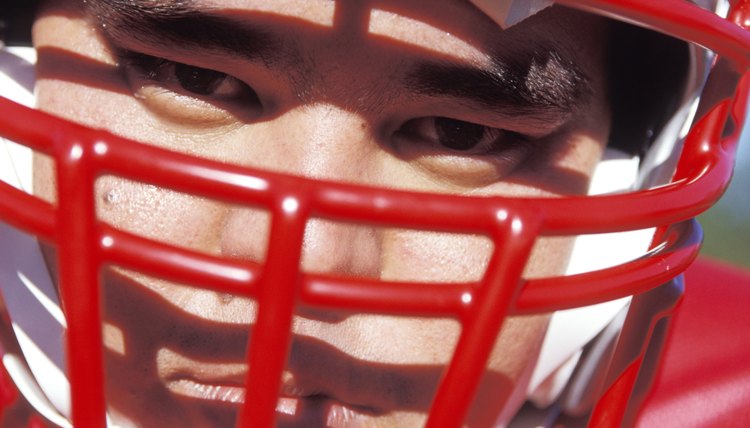Types of Padding in Football Helmets

An increased popularity -- at all levels -- in football caused an increase in player injuries, including fatalities. To address player safety, the National Operating Committee on Standards for Athletic Equipment. known as NOCSAE, began in 1969. Part of the NOSCSAE’s focus was on testing and regulating helmet padding. This resulted in padding placement inside football helmets and on the type of padding used at each location.
Helmet Basics
Your helmet is a combination of components designed to work together in protecting you while playing football. Although it might not seem like padding, a helmet’s hard, polycarbonate shell is the external padding that provides immediate protection against any hard objects you might encounter on the field. Attached to the shell is stiff expanded foam that cushions the entirety of your head. Throughout the expanded foam is additional padding of different stiffness. All this protection hides under a comfortable foam liner. Other components include a face mask, and in some helmets, an inner air liner.
Expanded Polypropylene Foam
The largest section of helmet padding is stiff polypropylene foam that nearly covers the entire internal surface of the helmet. Its main role is to absorb impacts and provide general protection. Throughout this protective layer sits additional protection strategically placed at points shown to receive harder impacts. To ensure this additional padding remains in place, the polypropylene layer is removed to provide a socket for the additional padding to sit without interfering with your comfort.
Vinyl Nitryl Foam
Because most tackles and blocks result in a head-down position, extra protection is require at the top of the helmet. In this location, the extremely stiff vinyl nitryl foam is placed to increase your protection against the impact of your head colliding with another football player. Its increased density gives you the greatest protection of head-on impacts.
Soft Foam
Along your forehead and lower jaws sits softer foam that provides protection without the stiffness associated with vinyl nitryl and polypropylene foams. Because this area of the helmet receives less impact, it does not require the strength of the other two foam types. Remember, this foam does not protect you from hits that twist your head from side to side.
Air Bladders
Certain types of football helmets have an adjustable air bladder designed to provide an additional layer of padding while increasing your comfort and the fit of the helmet to your head. An inflation port -- located at the back of the helmet -- always you to add or remove air from the bladder. This allows you to tailor the fit of your helmet.
References
Writer Bio
Lynda Schwartz is a fitness professional who began writing in 2004. She has contributed to "Women's Day" and "Good Housekeeping" magazines, as well as covered fitness and well-being for online publications. Schwartz holds a bachelor's degree in exercise science and health promotion.
